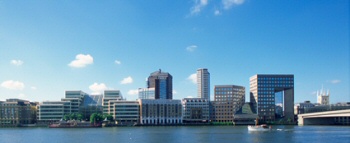London Bridge City
 Architects
Architects
The waterfront in London just south of the River Thames is a mixed-use development and shopping complex that goes by the name London Bridge City. The Commercial and residential development was the brainstorm of St. Martins, a well-known leading property management company after acquiring the property. The company commissioned Twigg Brown Architects to create an architectural master plan for the development. The company's architecture is driven by the quest for quality because quality embraces the performance of buildings. The company believes that our surroundings can influence the quality of our lives.
Design and Construction
London Bridge City consists of a handful of developments and includes a modern glass office block and a converted wharf. The office block, which is known as Cotton Centre is part of London Bridge City and provides modern office space. The building is an eye-catching creation in glass that is tinted green and the design maximizes the waterfront location. The design allows for unbelievable views of the river and was completed in 1986. The office complex overlooks the city pier. The structure features a rather large atrium with water features, glass sculptures, as well as greenery and is nine stories high. In addition, there is an elevator that leads down to the adjacent Hay's Galleria.
Hay's Galleria is an exquisite shopping complex. Construction started in 1982 and was completed in 1986 and continues the tradition of English upscale shopping arcades. The Galleria is part of a conversion of the old wharf and dock area on the South Bank. A moving sculpture of steel called the Navigator by David Kemps provides a distinctive focal point for both Hay's Galleria and for London Bridge City.
History
The South Bank experienced a rapid reduction in population during the early part of the 20th century. The waterfront area is now in an advanced stage of regeneration. Declining industries have given way to shops, residential developments, restaurants and galleries. Not much of the past remains. Hay's Wharf and the original warehouses were built and designed in 1856. The wharf was one of the first places to use cold storage. The headquarters for Hay's wharf, known as the Olave's house was built in 1932 and at the time this structure was extremely controversial. However it is now recognised as an Art Deco treasure and is also being restored.
Hay's Galleria, was once a warehouse and associated Warf for the port of London and redeveloped in the early 1980's. The warehouses were rebuilt after the war and again later. A steel and glass roof was installed on the dock, as part of the development of the Hay's Galleria. The warehouses have now all been restored and contain offices, apartments and shops. Hay's Wharf was known for being an unloading bay for ships filled with provisions for the London Trade. The wharf was simply converted by filling in the dock and covering it with glass. All of the surrounding buildings have been refurbished and are now bistros and shops.
Current Usage
Today, London Bridge City is a prestigious development that provides offices, residential apartments, a private hospital and a shopping and leisure complex. Presently, Hay's Galleria is a foremost waterfront tourist attraction.
The closest London Underground Stations to London Bridge City are London Bridge, Monument, Borough, Tower Hill and Southwark.
